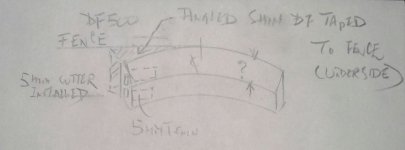Hi all,
New domino owner here. I'm working on a chair with some bent lam horizontal back slats that will mate with the back stiles (see photo for example)
I'm looking to replace the m&t joinery with dominos.
As a new user, it seems I have 2 options: an offset 4x20 or an angled 5x30.
The 4x20 seems like it would be easier (this may be my naivete showing) but would result in a tenon that doesn't get more then about 6mm into the slat due to risking blowing out the front of the slat (see photo) or risk of it loosening/leveraging out eventually..
The 5x30 gets deeper into the slat but it will need angled mortises. (See photo)
The slats are 2-3/4" (narrow ones) and 3-1/4" wide (wide ones) so I'll likely be doing double tenons for both.
Curious to hear all your opinions on which method is better and, if the 5x30 is recommended, any tips or tutorials on making these complementary angled cuts? Perhaps a video that can guide me?
Thanks in advance!



Sent from my SM-G981V using Tapatalk
New domino owner here. I'm working on a chair with some bent lam horizontal back slats that will mate with the back stiles (see photo for example)
I'm looking to replace the m&t joinery with dominos.
As a new user, it seems I have 2 options: an offset 4x20 or an angled 5x30.
The 4x20 seems like it would be easier (this may be my naivete showing) but would result in a tenon that doesn't get more then about 6mm into the slat due to risking blowing out the front of the slat (see photo) or risk of it loosening/leveraging out eventually..
The 5x30 gets deeper into the slat but it will need angled mortises. (See photo)
The slats are 2-3/4" (narrow ones) and 3-1/4" wide (wide ones) so I'll likely be doing double tenons for both.
Curious to hear all your opinions on which method is better and, if the 5x30 is recommended, any tips or tutorials on making these complementary angled cuts? Perhaps a video that can guide me?
Thanks in advance!



Sent from my SM-G981V using Tapatalk

